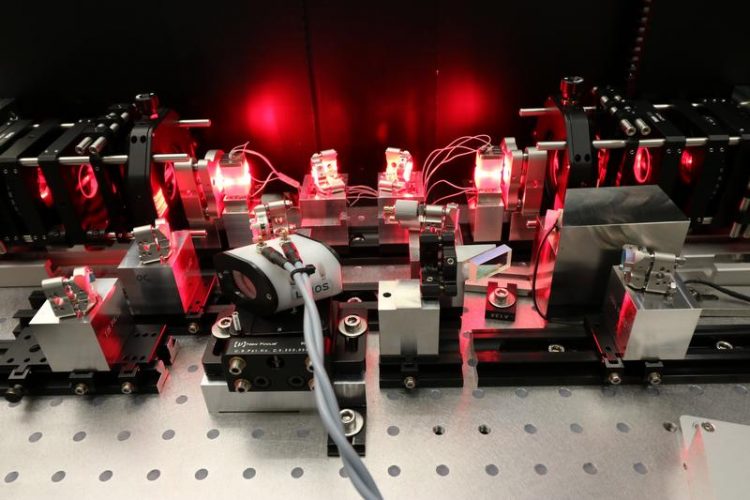Satellite-based Laser Measurement Technology against Climate Change

Picture 1: Lab demonstrator of a diode-pumped alexandrite laser for climate-relevant measuring in high-altitude atmosphere. © Fraunhofer ILT, Aachen, Germany
The fight against global climate change poses one of the greatest challenges of the coming decades. To develop effective measures against global warming, scientists need climate models that reliably represent interrelationships in the atmosphere. Currently, there is insufficient data about such relationships at high altitude (mesosphere), where crucial processes for global air circulation occur.
For the measurement of temperature and wind speed at this altitude, climate researchers rely on the modern resonance-lidar process. However, due to the complexity and the weight, these laser measuring systems are being used almost exclusively on the ground.
The work in ALISE constitutes the first step in developing a satellite-based observation system that enables wind and temperature conditions to be measured temporally and spatially in high-resolution in the mesosphere.
To accomplish this, the efficiency of the laser beam source, an alexandrite laser, needs to be increased by using laser diodes as a pump source. Furthermore, complexity and component weight will be reduced so that the requirements for space-based missions can be met.
In order to take advantage of laser measurement technology in satellite-based Earth observation, the scientists from Aachen have applied their many years of experience and expertise to developing laser beam sources and optical components for atmospheric measurements.
They were already able to demonstrate this, among others, in the Franco-German climate mission »MERLIN« and the »CHARM-F« project. The CHARM-F system recently successfully completed its first flight on the German research aircraft HALO (High Altitude and Long Range Research Aircraft) of the German Aerospace Center (DLR).
ALISE is supervised by the DLR, while the project budget is entirely provided by the Federal Ministry of Economic Affairs and Energy (FKZ: 50RP1605).
Please visit the DLR-website for additional information about the ALISE project: www.dlr-innospace.de/startseite/gefoerderte-projekte/alise/
Contact
Dr. rer. nat. Michael Strotkamp
Nonlinear Optics and Tunable Lasers Group
Phone +49 241 8906-132
michael.strotkamp@ilt.fraunhofer.de
Dipl.-Ing. Hans-Dieter Hoffmann
Head of the Competence Area Lasers and Laser Optics
Phone +49 241 8906-206
hansdieter.hoffmann@ilt.fraunhofer.de
Media Contact
All latest news from the category: Machine Engineering
Machine engineering is one of Germany’s key industries. The importance of this segment has led to the creation of new university degree programs in fields such as production and logistics, process engineering, vehicle/automotive engineering, production engineering and aerospace engineering among others.
innovations-report offers informative reports and articles covering technologies such as automation, motion, power train, energy, conveyor, plastics, lightweight construction, logistics/warehousing, measurement systems, machine tools and control engineering.
Newest articles

Bringing bio-inspired robots to life
Nebraska researcher Eric Markvicka gets NSF CAREER Award to pursue manufacture of novel materials for soft robotics and stretchable electronics. Engineers are increasingly eager to develop robots that mimic the…

Bella moths use poison to attract mates
Scientists are closer to finding out how. Pyrrolizidine alkaloids are as bitter and toxic as they are hard to pronounce. They’re produced by several different types of plants and are…

AI tool creates ‘synthetic’ images of cells
…for enhanced microscopy analysis. Observing individual cells through microscopes can reveal a range of important cell biological phenomena that frequently play a role in human diseases, but the process of…





















